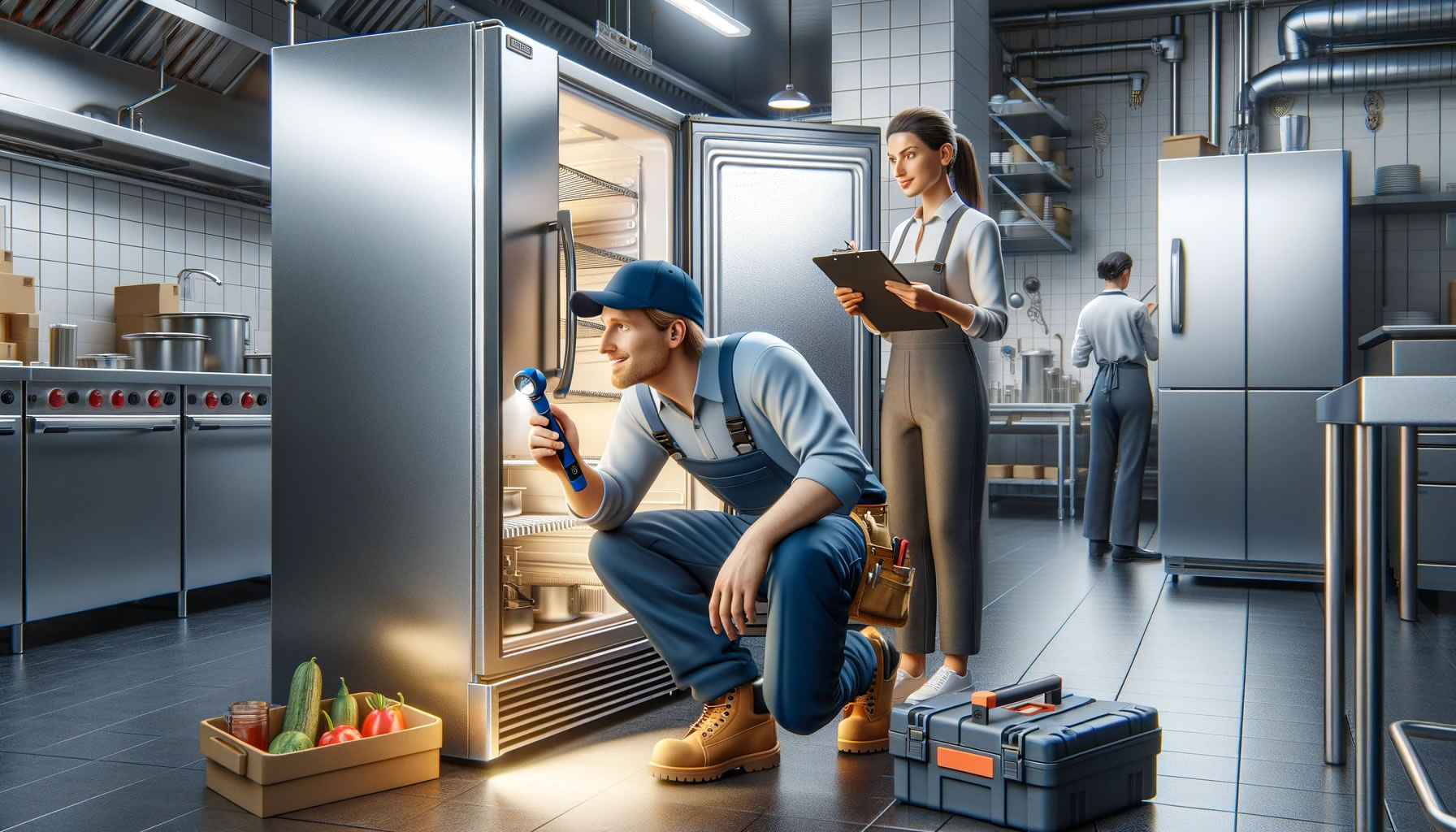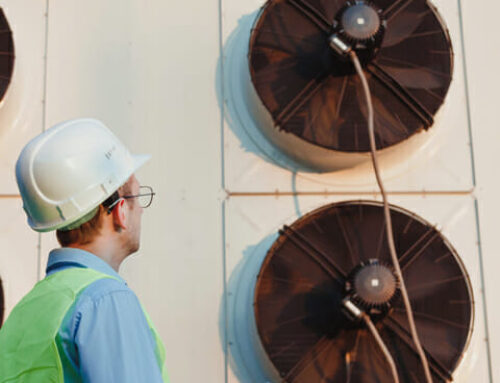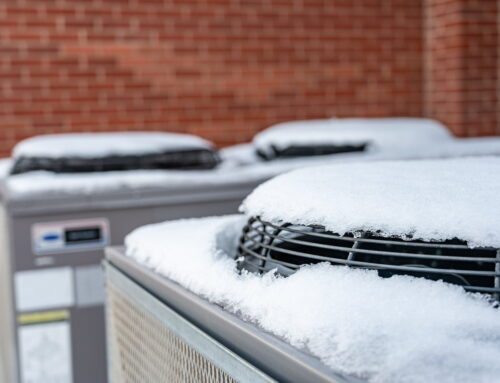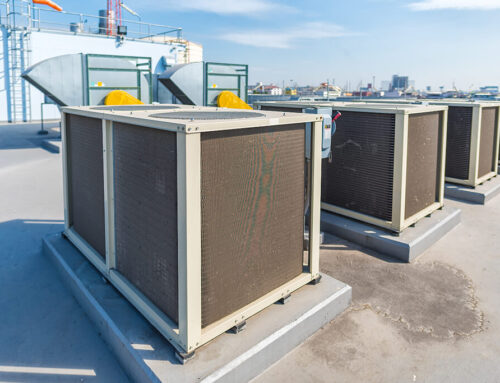-
-
How often should I clean my commercial refrigerator’s condenser coils?
-
What’s the best way to prevent mold in my refrigeration unit?
-
Can regular maintenance save energy on my commercial fridge?
-
Why is checking the gasket important for refrigeration maintenance?
-
How do temperature settings impact commercial refrigeration performance?
-
What components should be checked regularly to enhance airflow in my fridge?
-
Does warranty coverage include all aspects of commercial refrigeration maintenance?
-
Ensuring your commercial refrigeration equipment hums with efficiency isn’t just about avoiding unexpected meltdowns; it’s a cornerstone of running a savvy food-related business. Having a checklist for regular maintenance and working with a reliable contractor are key steps in this process. Regular commercial refrigeration maintenance is the unsung hero in preserving both the crispness of your greens and the longevity of your machines. Ensure your contractor follows a thorough equipment checklist to maintain optimal performance. Proactive care of your commercial refrigeration equipment is a financial no-brainer: a thorough checklist slashes costs by dodging hefty emergency fixes and keeps health inspectors nodding in approval. Trust us at Our Philosophy, an ounce of prevention with Our Services, including a thorough checklist for refrigeration equipment, is worth pounds of cure—and peace of mind through Our Methodology.
From corner delis to culinary empires, every chiller owes its chill to meticulous upkeep through Refrigeration Repair Services, guided by a comprehensive equipment checklist. Commercial Refrigeration Equipment Solutions are the backbone of businesses like these, and it’s About Evolution Mechanical to ensure they run smoothly. Aligning with manufacturer guidelines for Commercial Refrigeration Solutions not only ensures that your equipment stays frosty but also guards the gateway to food safety and quality—two pillars upon which customer trust is built.
Essential Steps for Maintaining Commercial Refrigeration
Maintaining a commercial refrigerator is crucial for business operations. Regular upkeep helps prevent breakdowns and ensures efficient performance.
Routine Inspections
A commercial refrigerator works non-stop. It’s important to catch problems early. Schedule routine inspections and maintenance plans to avoid unexpected issues that can disrupt your business.
Professionals look for signs of wear and tear during these checks. They might find small problems before they turn into big ones. For example, a technician could spot a failing component. This foresight saves money and prevents food spoilage.
Inspections should happen at least twice a year. But, if your fridge gets heavy use, consider more frequent checks.
Thermostat Settings
The right temperature keeps food safe. Verify your thermostat settings regularly. This is one of the most important steps in refrigeration maintenance.
An accurate thermostat ensures consistent temperatures inside your fridge. If it’s off, you could waste energy or spoil food. Both are bad for business.
You want to aim for the ideal temperature range for your products. For most foods, this means keeping the fridge below 40°F (4°C). Regularly checking the thermostat can help maintain this balance.
Door Closure
Your fridge’s door must seal properly every time it closes. Ensure proper door closure to keep the cold air in and warm air out.
A good seal protects the internal climate of your fridge. When doors don’t close right, your unit works harder to stay cool. This extra effort can lead to higher energy bills and wear out components faster.
Check gaskets and auto-closers often for signs of damage or wear. Replacing these parts when needed can save you from bigger repairs later on.
Monthly and Quarterly Maintenance Guides
Keeping your commercial refrigeration running smoothly requires routine maintenance. By integrating our methodology into your maintenance plans, following a monthly and quarterly schedule, you can prevent unplanned downtime and ensure consistent performance for our growing client base.
Monthly Maintenance Checklist
Every month, it’s crucial to perform HVAC maintenance services to maintain the efficiency of your refrigeration system. A clean coil is key for optimal operation. Dust and debris can build up on the coils, leading to decreased efficiency and increased energy costs.
-
Clean evaporator and condenser coils.
-
Check for any unusual noise or vibrations.
-
Ensure temperature consistency within the unit.
-
Examine door seals and gaskets for leaks.
Regular cleaning prevents a lot of potential issues. For example, when coils are dirty, they can’t release heat properly. This makes your system work harder, which can lead to bigger problems down the line.
Quarterly Tasks Overview
On a quarterly basis, more in-depth checks are necessary. These tasks might require more technical knowledge but are essential for long-term maintenance.
-
Inspect refrigerant levels; refill if necessary.
-
Test compressor operation; listen for irregularities.
-
Verify that all fans are working correctly.
-
Tighten electrical connections as needed.
The compressor is like the heart of your refrigeration system—it needs regular check-ups. If it’s not working properly, your system could fail without warning. That means spoiled food or medicine, which could be costly for your business.
Documentation Importance
Documenting each maintenance activity helps track the health of your equipment over time. Our Installation and Sales Services also provide valuable information for warranty claims or service calls. For more details, please visit our Contact Page.
-
Keep a logbook or digital record of all maintenance activities.
-
Note any changes in performance after servicing.
-
Update your records with any replaced parts or repairs made.
This documentation serves as evidence that you’re taking proper care of your equipment. Manufacturers often require proof of routine maintenance for warranty purposes.
Consistent Cleaning and Condenser Coil Maintenance
Maintaining commercial refrigeration is crucial for efficiency and longevity. Regular cleaning and coil maintenance prevent issues like overheating.
Cleaning Frequency Matters
Regular HVAC maintenance services include cleaning condenser coils to prevent overheating and potential equipment failure. Overheating strains the system, causing wear and higher energy bills. Experts recommend cleaning these coils at least every three months. This frequency can increase in environments with more dust or grease.
Regular maintenance ensures your refrigeration unit remains in good condition. It keeps the system running smoothly, preventing unexpected breakdowns. A clean condenser coil maintains proper temperature control, essential for food safety.
Safe Coil Cleaning Techniques
Cleaning a condenser coil isn’t just about wiping off dirt; it requires technique. First, turn off the power to ensure safety. Use a brush or vacuum to remove loose debris from the coils carefully.
For a deeper clean, apply a commercial-grade cleaner designed for condenser coils. Let it sit according to product instructions before rinsing with water if needed. Always follow manufacturer guidelines for specific cleaning methods suitable for your equipment.
Avoid using harsh tools that could damage the fins on the coil. Soft brushes are best as they clean without causing harm.
Spotting Coil Damage
Regular inspections can reveal signs of wear or damage on your condenser coils that need attention:
-
Bent fins restrict airflow and reduce efficiency.
-
Corrosion indicates potential leaks or system failures.
-
Excessive noise during operation may signal internal problems.
If you notice any of these signs, contact a professional contractor immediately. They can assess whether repairs or replacements are necessary.
Preventative maintenance goes beyond simple cleaning; it involves being vigilant about changes in performance. Keep an eye out for increased energy consumption or inadequate cooling—these could be clues of underlying issues with your evaporator or condenser coils.
Gasket, Air Filter, and Seal Inspections
Just as consistent cleaning and coil maintenance are vital for your commercial refrigeration system, so too is the regular inspection of gaskets, air filters, and seals. These components are crucial in maintaining an efficient and reliable unit within energy efficiency management.
Check Gasket Elasticity
Gaskets are essential in refrigeration repair services, ensuring the cold air remains inside your refrigerator. They line the doors, creating a tight seal when closed. Over time, gaskets can lose their elasticity due to constant use and exposure to harsh kitchen environments. This can lead to costly air leaks. Regular checks for cracks or stiffness in your door gaskets will help catch issues early on. When you find that a gasket isn’t as pliable as it should be or if you see visible damage, it’s time for a replacement.
Replace Worn Filters
Air filters are another component that should not be overlooked. They ensure clean airflow within your refrigeration system which helps maintain temperature consistency and efficiency. A clogged or dirty filter strains the unit’s compressor and can increase energy costs dramatically. It’s recommended to inspect these filters regularly and replace them when they show signs of wear or at least every three months.
Inspect Seals Routinely
The integrity of seals is just as important as gaskets for preventing air leaks. Routine inspections help identify any signs of wear or failure before they become serious problems. Look for gaps or areas where the seal doesn’t adhere properly to the refrigerator structure; this could indicate it’s time for immediate replacement.
Preventive Measures for Optimal Refrigeration Performance
Maintaining commercial refrigeration is crucial for preserving food quality. Implementing simple energy management techniques can significantly enhance your refrigeration unit’s performance.
Minimize Door Openings
Every time the fridge or freezer door opens, warm air enters. This disrupts the internal temperature. To keep your food safe and your unit efficient, it’s important to reduce how often doors are opened.
Teach staff to plan their tasks so they open the door less often. For instance, if they need several items, they should take them all at once rather than opening and closing the door multiple times.
Align Shelves Properly
Shelving inside a refrigeration unit plays a big role in air flow. If shelves are misaligned, cold air can’t circulate properly. This leads to uneven cooling and can cause some food to spoil faster.
Make sure shelves have enough space between them for air to move freely. It might seem like a good idea to pack as much as possible into a fridge or freezer, but overloading it will lead to problems down the line.
Check Temperature Controls
The heart of any refrigeration system is its ability to maintain consistent temperatures. Regular checks and calibrations of temperature controls ensure that this consistency remains unbroken.
Have a routine where temperature gauges are checked daily for accuracy. If there’s ever a discrepancy, recalibrate them or call in a professional if necessary. Keeping an eye on these controls prevents future issues and saves money on energy costs too.
Mold Prevention and Ice Quality in Refrigeration Units
Maintaining commercial refrigeration is key to food safety and quality. Proper practices prevent mold and ensure high-quality ice.
Reduce Moisture and Mold
Moisture is the enemy of a clean refrigeration unit. It can lead to mold growth, which contaminates food products. To keep moisture at bay, start with regular inspections. Look for any leaks or condensation inside your refrigeration units. If you find moisture, address it immediately.
Here are strategies to reduce moisture:
-
Ensure proper door seals: Check that the door gaskets are intact and seal tightly.
-
Control humidity: Use a dehumidifier if your area has high humidity levels.
-
Regular cleaning: Wipe down surfaces with a mild disinfectant to kill potential mold spores.
-
Good air circulation: Keep products organized and avoid overstocking to allow air to flow freely.
By keeping the interior dry, you discourage mold from making itself at home in your refrigeration units.
Clean Ice Machines
Ice machines need attention too. Dirty ice machines can produce low-quality ice that may taste bad or contain contaminants. To maintain cleanliness:
-
Schedule regular cleaning: Follow the manufacturer’s guidelines for cleaning frequency.
-
Use appropriate cleaners: Select chemicals designed specifically for ice machines.
-
Change water filters regularly: This ensures clean water for ice production and extends the machine’s life.
Clean ice machines mean clear, tasteless, odorless ice – exactly what customers expect when they enjoy a cold beverage.
Adjust Defrost Settings
Excess ice accumulation can be as problematic as insufficient ice production. It can damage your refrigeration units by putting extra strain on them. The defrost settings on your unit play a critical role here:
-
Understand defrost cycles: Know how often and how long your unit goes into defrost mode.
-
Monitor temperature fluctuations: Frequent changes can cause excess frost build-up.
-
Consult with professionals: Have an energy consultations expert check if you’re unsure about optimal settings.
A well-adjusted defrost cycle keeps excess ice at bay without interrupting the cooling process necessary for preserving food items.
Energy-Saving Techniques and Temperature Management
After addressing mold prevention and ice quality, we turn our focus to energy-saving strategies in commercial refrigeration. Proper temperature management in sustainable building solutions not only conserves energy but also extends the life of your products.
Night Covers Usage
Night covers are a simple yet effective tool for energy conservation. When businesses close for the night, there’s no need to maintain the same visibility of products as during operating hours. Placing night covers over display cases significantly reduces electrical consumption by retaining cold air and reducing the workload on refrigeration units. Incorporating sustainable building solutions, this small action can lead to substantial savings on energy costs.
For instance, a supermarket that implements night covers as part of its energy efficiency management strategy might see a decrease in their monthly utility bills. The covers act as insulators, keeping the cold in and the heat out, which is particularly beneficial during summer months when temperatures rise.
Optimal Temperature Settings
The right temperature setting is crucial for both product quality and energy efficiency. Each type of food or beverage has its ideal storage temperature to maintain freshness without wasting energy. Adjusting set points according to what’s inside your refrigerators can cut down on unnecessary cooling and associated costs.
For example, meat requires lower temperatures compared to some fruits and vegetables. By tailoring the equipment settings based on contents and how often they’re accessed (usage patterns), kitchens can reduce downtime caused by overworking machines while still keeping everything at safe temperatures.
LED Lighting Benefits
LED lights have revolutionized lighting within commercial refrigeration units. Unlike traditional bulbs, LEDs emit very little heat, which means less work for your cooling systems to keep temperatures down. They also consume less electricity than other types of lighting—another win for reducing energy bills.
Beyond just cutting down consumption, LED lights provide better visibility with a cleaner light spectrum—making products look more appealing without adding extra heat into the area. This switch not only improves the interior appearance but also contributes positively towards managing surface temperature within display cases.
Understanding Warranty Coverage and Maintenance Benefits
When you buy commercial refrigeration, knowing the warranty and maintenance can save you money. Regular upkeep might even keep your warranty valid longer.
Know Your Warranty Terms
Understanding your commercial refrigeration’s warranty is crucial. It’s like having a safety net for your business. If something goes wrong, the warranty may cover repairs or replacements. But there’s a catch – you need to know what it includes and excludes.
Most warranties will not cover damage from improper use or lack of maintenance. So, if you don’t follow their rules, you could be left with a big bill. To avoid this:
-
Read the fine print when you purchase.
-
Keep records of all services done.
-
Follow manufacturer guidelines for use.
This knowledge helps ensure that if problems arise, you’re protected.
Leverage Warranty Services
Our Services can be a lifeline for businesses when parts fail unexpectedly, offering warranties. They help manage costs by covering component replacements without extra charges. Think of it as having insurance on your equipment; it gives peace of mind.
Here are ways to get the most out of your warranty service through our Installation and Sales Services. Don’t forget to utilize the Newsletter Sign-Up for updates, and feel free to reach out via the Contact Page for personalized assistance.
-
Schedule regular check-ups through authorized service providers.
-
Use only approved parts for any repairs or replacements.
-
Report issues promptly to avoid bigger problems later.
Implementing Energy Management Techniques and scheduling regular Energy Consultations can mean less downtime and more savings in the long run.
Maintenance Extends Warranty
Regular maintenance isn’t just good practice – it can also extend the life of your warranty. Think about it like caring for a car; regular oil changes keep it running smoother, longer.
For commercial refrigeration:
-
Clean coils prevent overheating and system failure.
-
Checking seals keeps cool air in and energy costs down.
-
Documenting maintenance proves to manufacturers that you’re taking care of their product.
All these actions show that you’re doing your part to prevent damage due to neglect. This could lead to extended coverage terms or easier claims processing if an issue does occur.
Enhancing Airflow and Component Checks
In commercial refrigeration, maintaining airflow and checking components are crucial for efficiency. Obstructions, fan issues, and frost can all hinder performance.
Clear Vents Regularly
Proper airflow is essential in a refrigeration system. It ensures cool air circulates inside, keeping items at the right temperature. But sometimes, vents can get blocked. When this happens, it’s like trying to breathe with a pillow over your face — not much air gets through!
Operators should regularly check for any debris that might obstruct vents. This could be anything from a misplaced food box to accumulated dust. Keeping these pathways clear allows the system to distribute air without strain.
Inspect Fans Often
Fans play a big role in moving air around in your fridge or freezer. Think of Our Philosophy as the heart of the system — it needs to be healthy for everything else to work well. Over time, fan blades can collect dust or become damaged which affects their performance.
A routine checklist should include:
-
Looking at fan blades for dirt buildup.
-
Ensuring they’re not bent or broken.
-
Checking fan motors for signs of wear or failure.
This kind of attention helps catch small issues before they turn into big problems.
Check Evaporator Coils
Evaporator coils, a key component About Evolution Mechanical, are where the magic happens; they absorb heat from inside so that cool air remains. However, if frost accumulates on these coils, it acts like an insulating blanket — warmth stays put and cold can’t do its job.
To prevent this:
-
Operators must observe coils for any frost or ice buildup.
-
They should also inspect tubing connected to the coils for leaks or damage.
-
A defrost cycle may be necessary if frost is found.
Remembering that component failure often starts small — a little bit of prevention goes a long way.
Conclusion on Effective Refrigeration System Upkeep
Keeping your commercial refrigeration in top shape is a no-brainer—it saves you money, keeps your food safe, and avoids those pesky breakdowns that can throw a wrench in your business operations. You’ve got the lowdown on everything from regular cleanings to energy-saving hacks. It’s like keeping your car in gear; stay on top of maintenance and you’ll dodge those costly repairs down the road.
Don’t just stand there with the fridge door open! Take action now. Schedule those maintenance checks, keep an eye on your seals and filters, and give mold the cold shoulder. Your bottom line will thank you—and so will your client base when they get that crisp, fresh taste they love after the newsletter sign-up. Ready to chill out about your refrigeration worries? Get cracking on that upkeep routine and keep it cool.
Frequently Asked Questions
How often should I adhere to a maintenance schedule for cleaning my commercial refrigeration equipment’s condenser coils to ensure effective preventative maintenance for freezers and refrigerators?
Clean them every 3 to 6 months. Dust and debris block airflow, straining the system.
What’s the best way to prevent mold in my commercial refrigerators and freezers? Regular preventative maintenance, including cleaning the evaporator coil, is essential.
Keep it dry and clean. Regularly wipe surfaces and check for excess moisture.
Can regular maintenance save energy on my commercial fridge?
Absolutely! Well-maintained units run more efficiently, using less power.
Why is checking the gasket important for refrigeration maintenance?
A tight seal keeps cold air in, reducing strain on the unit. Inspect them often!
How do temperature settings impact commercial refrigeration performance?
Proper settings ensure food safety and can lower energy costs. Check them daily!
What components in commercial refrigerators should be checked regularly on the commercial refrigeration equipment checklist to enhance airflow, such as the evaporator coil?
Ensure fans are working and vents aren’t blocked. Good airflow equals better cooling.
Does warranty coverage include all aspects of commercial refrigeration equipment maintenance, product repairs, contractor services, and work performed?
Not always. Warranties vary, so read yours carefully to know what’s included.






